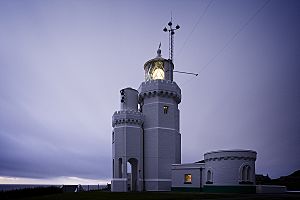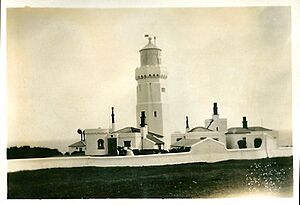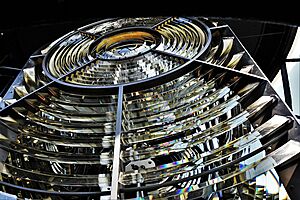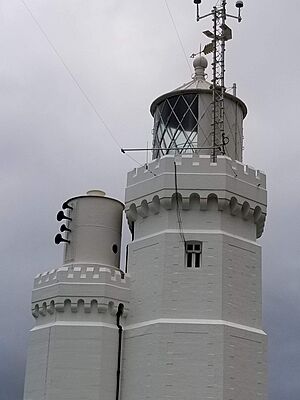St Catherine's Lighthouse facts for kids
 |
|
| The lighthouse, with fog-signal tower attached | |
| Location | St Catherine's Point Isle of Wight England |
|---|---|
| Coordinates | 50°34′32.4″N 1°17′51.9″W / 50.575667°N 1.297750°W |
| Year first constructed | c. 1323 (first) |
| Year first lit | 1838 (current) |
| Automated | 1997 |
| Construction | ashlar |
| Tower shape | octagonal tower |
| Markings / pattern | white tower and lantern |
| Height | 27 m (89 ft) |
| Focal height | 41 m (135 ft) |
| Intensity | 821,000 candela |
| Range | 19 nmi (35 km; 22 mi) |
| Characteristic | Fl W 5s. |
St Catherine's Lighthouse is a famous lighthouse found at St Catherine's Point, which is the very southern tip of the Isle of Wight. It's one of the oldest places in Great Britain where a lighthouse has stood!
Contents
The First Lighthouses
The Pepperpot: A Medieval Beacon
The very first lighthouse here was built way back in 1323. It was placed on St Catherine's Down. The Pope ordered it after a ship got stuck nearby and its goods were lost. This old stone tower was once part of St Catherine's Oratory. You can still see its eight-sided shape today on the hill west of Niton. Locals call it the "Pepperpot" because of its shape.
The Unfinished "Salt Pot"
Later, in 1785, people started building a new lighthouse nearby. But it was never finished! The hill where it was being built often gets covered in thick fog. This made it a bad spot for a lighthouse. This unfinished building is sometimes called the "Salt Pot".
History of the Current Lighthouse
Building the Modern Tower
The lighthouse you see today was built by Trinity House in 1838. It was first a tall stone tower, about 40 meters (131 feet) high. When it first opened, the light came from an oil lamp. This lamp had four wicks and a large Fresnel lens. This special lens helped make the light very bright and focused. The lighthouse first shone its light on March 1, 1840.
Changes and Challenges
However, the light was often hidden by fog. So, in 1875, the tower was made shorter by 13 meters (43 feet). At the same time, the oil lamp was updated. A new system of prisms was added to send light out to sea, even from the landward side.
Fog Signals and Sounds
In 1868, a Daboll trumpet fog signal was added. It was in a building right on the cliff edge. This trumpet used an engine to make a loud sound, like a horn, every 20 seconds. In 1876, the sound was changed to a more powerful siren. It would blast twice every four minutes.
Switching to Electric Power
In the 1880s, the lighthouse was updated again. It was decided to make the light electric! In 1888, a powerful electric lamp was installed. It was powered by special machines that used steam engines. St Catherine's was the last lighthouse in England to get this type of electric lamp.
A new, faster-spinning lens was also added. It flashed every five seconds. When it first started, St Catherine's was said to have "the most powerful electric light in the world." The old oil lamp was kept as a backup, but it was never needed because the electric system worked so well.
New Buildings and More Staff
With the new electric system, more buildings were needed. An engine house was built, and more cottages were added for the extra staff. A new fog signal house was also built in 1888. It had two loud sirens that blasted through horns angled out to sea. These sirens sounded two blasts every minute: one high note, then one low note.
Adding a Warning Light
From 1890, a narrow red light was added. This "sector light" warned ships to stay away from the shore west of St Catherine's Point. This red light shone from the same main lamp, but was redirected to show red in that specific direction.
Testing New Fog Signals
In 1901, scientists tested different sirens and horns at St Catherine's. They wanted to find the best way to make loud fog signals. These tests helped improve fog signals used at other lighthouses.
A Brighter Light in 1904
In 1904, the old lens was replaced with an even more powerful one. This new lens spun much faster, making the light flash every five seconds. It was said to be "the most powerful flash-light in the country." Its beam was so strong it could sometimes be seen from 60 miles away! The red warning light was also moved to a lower window in the tower.
Modernizing the Light
The powerful electric lamp was removed in the 1920s. It was replaced with a modern electric light bulb. An automatic system was added to switch to a backup bulb if the main one failed. There was even a backup gas lamp in case of a power cut.
Wartime Damage and Repairs
By 1932, the fog horn house was getting damaged by erosion from the sea. It was taken down, and a smaller tower was built next to the lighthouse for a new, stronger siren. Sadly, on June 1, 1943, during a bombing raid, the engine house was destroyed. Three lighthouse keepers on duty lost their lives. After the war, new fog signals were installed as part of the repairs.
Automation and Updates
The lighthouse became automated in 1997. This meant keepers no longer had to live there all the time. In the early 2000s, a special antenna was added to send out navigation signals for ships.
For many years, volunteers offered tours of the lighthouse. However, in January 2020, Trinity House announced that the lighthouse would close to visitors. They said it was no longer possible to keep the visitor center open.
Up until 2021, the 1904 revolving lens system was still in use. It was one of the most powerful lights managed by Trinity House. But in November 2020, plans were approved to remove this old lens and replace it with a modern LED light.
St Catherine's Lighthouse Today
New LED Lights
In July 2021, the lighthouse's range was updated. Later that year, the large 1904 Fresnel lens system was removed. For a short time, a temporary lamp was used. In 2022, it was replaced with two modern LED lanterns. One is the main light, and the other is a backup.
Warning Ships
A red sector light still shines from a lower window in the tower. This light helps warn ships about Atherfield Ledge, a dangerous area near the shore. This red light was also updated in 2021.
A Piece of History Returns
In 2023, the old 1904 lens system was brought back to the Isle of Wight. It is now on display at the Classic Boat Museum in Cowes.
You can even rent out three of the former lighthouse keepers' cottages as holiday homes!
See also
 In Spanish: Faro de Punta de St. Catherine para niños
In Spanish: Faro de Punta de St. Catherine para niños
- List of lighthouses in England






